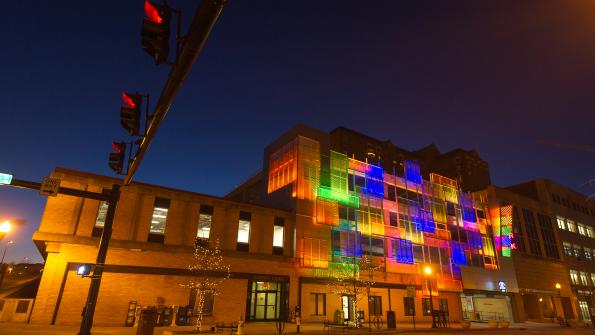A tale of three cities
Smart parking, which uses technology to make the most of existing parking resources, has created unprecedented opportunities for municipalities to better access mobility options, increase revenue, facilitate enforcement, meet sustainability goals and make the parking experience more efficient and customer-friendly. Three cities, in particular, stand out for their utilization of these solutions in innovative ways:
Seattle: A Data-driven Approach Maximizes Limited Space
Seattle has experienced unprecedented population growth during the past several years. Nearly 685,000 people share the narrow isthmus between Puget Sound and Lake Washington – reaching 2 million in the Greater Puget Sound area. This sudden growth has given rise to a myriad of parking and transportation issues, to which the city has applied forward-thinking, technology-centric solutions.
“We’ve taken a data-driven approach to how we manage curb space and public right-of-way,” says Mike Estey, manager of parking programs for the Seattle Department of Transportation (SDOT). Estey is also a member of the Smart Cities Collaborative, whose 16 city members work collectively to create policies, pilot emerging technology and share insights on how to tackle urban mobility challenges.
Seattle allows customers to pay at multi-space pay stations by credit card or by phone which not only makes it easier for the user but allows the city to gather data about peak-parking conditions and adjust hourly rates and/or time limits by neighborhood. This ensures a balanced, 70 to 85 percent occupancy and continuous space availability on each city block.
An innovative electronic parking guidance system, operated in partnership with the city’s private parking facility owners, uses dynamic real-time message signs and a mobile-friendly website to direct drivers to available off-street parking at numerous downtown garages. This results in fewer cars circling looking for parking. Seattle also collaborates with three car-sharing vendors to promote shared mobility.
Houston: Technology Reduces Circling, Emissions and Congestion
In some ways, Houston is the flip side of Seattle —its 674 square miles provide ample land for parking, the majority of which is privately owned. With 4 million residents, half of whom live within city limits, Texas’s most populous city houses a huge medical center, attracting the world’s largest concentration of healthcare and research institutions; NASA’s Johnson Space Center; and a growing energy and manufacturing corridor. The result? Congestion and competition for close-in parking spaces, which, despite Houston’s sizable footprint, are in limited supply.
To reduce congestion, circling and emissions, the city has focused on using technology to help drivers find and pay for parking faster, says Maria Irshad, assistant director of ParkHouston. Meters have been replaced with smart pay stations with license-plate recognition and pay-by-phone capabilities. A new parking guidance system, still in its initial stages, extracts real-time data from parking facilities and sends it to a website and phone app. Dynamic highway wayfinding signs take drivers directly to available parking spaces. A vendor partnership provides on-street car sharing, which allows drivers to rent a car for time periods ranging from one to 24 hours, unlock it via a downloadable app and return it where they found it.
“It behooves us to support alternative modes of transportation,” Irshad says. “Each shared vehicle takes nine to 13 vehicles off the road.” She says the city is moving toward creating an app that will display pay-by-phone parking, car-share, bike-share, Uber and other options, so drivers can make the best decisions on parking and transportation.
Lexington, Ky.: Embracing Parking Technology and Transportation Alternatives
In a college town like Lexington, the ParkMe app is perfect for a generation that thrives on spontaneity. It allows drivers to locate available off-street parking on a map within seconds, quickly assess the least-expensive options, and reserve their spaces online, says Gary Means, executive director of the Lexington Park Authority. It lets users reserve their space using a credit card and show proof of purchase when they arrive. Not only does this system maximize what would otherwise be underutilized parking capacity, it carries additional benefits such as reduced onsite theft and risk for parking lot attendants.
Means points out that the success of programs like Lexington’s underscores the importance of having a parking professional at the table who sees the big picture—that smart parking is a centerpiece of healthy downtown function and integral to the whole transportation picture.
“Today’s smart cities are looking not just at smart technology, but at how to manage transportation demand, reduce single-occupancy vehicle use, promote bicycle infrastructure and bus and rail programs, reduce congestion and clean up air quality,” Means adds. “My industry colleagues and I manage all of these issues daily, as well as how to make parking more sustainable.” Lexington’s award-winning, $4 million parking garage rehabilitation incorporated numerous sustainability features and significantly prolonged the life of the 40-year-old structure.
“Many cities are cash-strapped and reluctant to invest in new technology, but it usually pays for itself quickly,” Means says. “And the cost is often passed on to the user.”
Michele Ostrove is a freelance writer based in Santa Fe, N.M. Additional parking resources are available from the International Parking Institute (IPI) at www.parking.org. There you can also find a joint study on parking conducted by IPI and American City and County.
p.p1 {margin: 0.0px 0.0px 15.0px 0.0px; line-height: 22.2px; font: 15.0px Georgia; color: #323333}
p.p2 {margin: 0.0px 0.0px 15.0px 0.0px; line-height: 22.2px; font: 12.0px Georgia; color: #323333}
span.s1 {font-kerning: none}
span.s2 {font: 12.0px Georgia; text-decoration: underline ; font-kerning: none; color: #0e5f8b}
span.s3 {font: 15.0px Georgia; font-kerning: none}
_____________
To get connected and stay up-to-date with similar content from American City & County:
Like us on Facebook
Follow us on Twitter
Watch us on YouTube




















